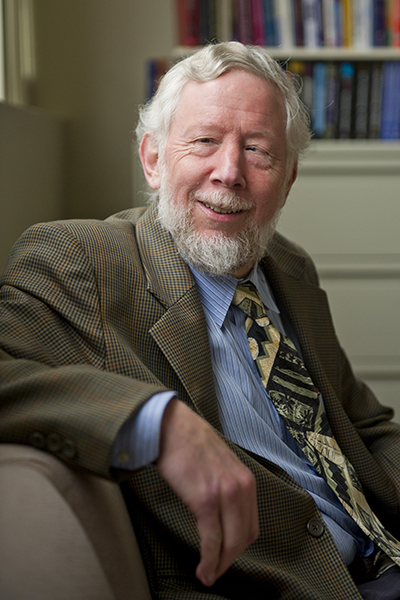Patient-Centered Team Treatment of Schizophrenia Works Best
SAR professor senior author on landmark study

Kim Mueser has spent decades helping people with schizophrenia and other serious mental illnesses recover and rebuild their lives. A Sargent College of Health & Rehabilitation Sciences (SAR) professor and executive director of the Center for Psychiatric Rehabilitation (CPR), clinical psychologist Mueser is a pioneer in developing an evidence-based approach to treatment and rehabilitation. This approach is aimed at assisting people to reclaim relationships, return to work or school, manage their illness in collaboration with counselors and therapists, and improve their overall health.
Now, a landmark study funded by the National Institute of Mental Health and coauthored by Mueser has shown that this kind of comprehensive, team-based, patient-centered approach, combined with low doses of antipsychotic drugs, is more effective in helping people experiencing a first psychotic episode—a symptom of schizophrenia—make progress in recovery over the first two years of treatment than those who got the usual drug-focused care. More than two million people in the United States have been diagnosed with schizophrenia, and most receive piecemeal care and are treated with antipsychotic medicines that decrease hallucinations and delusions, but that can also have significant side effects, like weight gain and tremors.
The study of 404 patients at 34 community mental health centers in 21 states, published in October 2015 in the American Journal of Psychiatry, is the largest, most rigorous trial of a program to day for the treatment of first episode psychosis in the United States. The Centers for Medicare & Medicaid Services, as well as National Institutes of Health director Francis Collins, have endorsed the approach.
Mueser helped lead the effort to create the psychosocial part of the program, called NAVIGATE, which was designed to be workable in routine treatment settings serving people with serious mental illness within the US health care system and reimbursed by existing insurance plans. Schizophrenia usually begins in late adolescence or adulthood and is accompanied by psychotic symptoms such as hallucinations or delusions, as well as depression and loss of energy and drive. People have difficulty working, going to school, fulfilling parental and other family responsibilities, and managing other aspects of their daily lives. Psychotic symptoms often go untreated for many months and even years before effective treatment is provided. Programs that focus on people recovering from a first episode of psychosis aim to improve the long term course of their illness by providing comprehensive treatment as soon as symptoms are detected.
Mueser says the study demonstrates that it is possible to deliver effective, comprehensive, individualized treatment for schizophrenia early on and within the US health care system, and that such care improves the lives of people with these mental health conditions. “The thing that really buoys my spirits and my hopes is that we really can help people who are struggling with psychotic symptoms for the first time in their lives,” he says.
“With first episode psychosis, you have the opportunity to get the treatment right, from early on, before individuals and their families give up,” he adds. “We see improvements across the board—in social relationships, at work and in school, in reduction of the severity of symptoms, in all the things that are most important to people experiencing an episode of psychosis. This shows that having a team of mental health professionals who share the goal of promoting recovery from a first episode and who work together to integrate psychosocial and pharmacological treatments can be effective at improving people’s functioning and their quality of life.”
One of the keys to the success of NAVIGATE, Mueser says, is that teams of mental health specialists collaborated with patients—and their families—to develop individualized treatment plans. “The overall team worked together, had regular meetings, planned how to coordinate the different treatment components,” he says. “Everything was driven by what the clients’ goals were. Decision-making was shared, and everyone worked together, including the client, family, and the NAVIGATE team.”
The study and the large group of researchers involved was led by John M. Kane, a professor and chairman of the psychiatry department at Hofstra North Shore—LIJ School of Medicine.
“The biggest trouble in the field is that at most of the centers where people get treatment, they receive medication and some case management—a little bit of this, a little bit of that,” Mueser says. “But they do not tend to receive comprehensive treatment, including evidence-based practices shown to be effective in rigorous research studies, such as supported employment or family education.”
Riddled with delays, contradictory information, inadequate treatment
Schizophrenia affects 1.1 percent of Americans age 18 and older, and accounts for about 30 percent of all spending on mental health treatment, the NIH’s Collins wrote in a blog posting about the study the week it was published. “For far too many young people and their families,” he wrote, “the search for help is riddled with long delays, contradictory information, and inadequate treatment in a mental health system whose resources have been stretched thin.
“There’s got to be a better way to reach more of these young people,” Collins wrote, and the results of the study “point to a possible way to get there.”
In 2014, after preliminary results of the study had been made public, Congress awarded $25 million in block grants to states for early-intervention comprehensive mental health treatment programs. In an article about the study, the New York Times reported that 32 states have begun using those grants to fund combined-treatment services.
In addition to personalized medication management, NAVIGATE has three parts:
- Individual cognitive behavioral therapy that includes training in resiliency, learning tools for building social relationships and managing symptoms, and understanding and working through the psychotic episode.
- Supported education and employment: a counselor helps the patient to return to school or find employment as quickly as possible. Support is provided at work or school to help the patient stay on track.
- Educating the family in understanding the illness.

Clinical psychologist and CPR senior researcher Jennifer Gottlieb, an author on the study, worked with Mueser and others in developing the psychosocial treatment, training and supervising mental health professionals at the community mental health centers, and implementing the program. “We took different components of different kinds of interventions that had empirical support as treatments for schizophrenia and brought them together to create a comprehensive individual skills-based therapy intervention,” says Gottlieb, a SAR research assistant professor of occupational therapy and a College of Arts & Sciences research assistant professor of psychological and brain sciences, who has focused her work on psychosocial treatment for people with serious mental illnesses.
In addition to helping people manage their symptoms—for example, learning how to cope with voices they may hear—the therapy is aimed at helping people understand that they are much more than their illness. “One of the awful things about having a psychotic episode is that all of a sudden, you’re pathologized—you’re a patient,” Gottlieb says. “We’re helping people tap into positive characteristics that they have always had or that they have developed over time in the face of confronting a psychotic episode to help them recover and move forward in meaningful ways. People have this perception that if you have this psychosis or a family member receives this diagnosis, that’s it, they’re done for. That’s one of the most tragic things—they’ve lost hope.”
For the study, the NAVIGATE program was implemented in community mental health centers in rural, suburban, and metropolitan areas that serve people from diverse racial and cultural backgrounds. “There’s more or less evidence that we can implement this program in different places,” Mueser says. “Those findings are very important to the field.”
Another key finding, he adds, is that the longer a person is psychotic, the harder it is to treat them and the less effective the intervention is. “That really should have the potential of increasing education campaigns and other approaches aimed at getting people connected with services so they can be treated faster and more effectively,” he says.
The two-year study enrolled 404 people, age 15 to 40, all of whom had experienced one episode of psychosis and been given less than six months of antipsychotic medications. It was a randomized trial, with about half the volunteers receiving the NAVIGATE program and half receiving the usual medication-focused treatment. Clinicians monitored and evaluated both groups in such categories as symptom severity and quality of life—for example, whether a person is working or going to school, and how well they are relating to other family members.
The group that started on NAVIGATE had lower scores, on average, on those two measures at the start of the trial. Both groups showed steady improvement over the two years of the study. But by the end, the NAVIGATE participants had made more improvements in their quality of life, as well as in the lessening of symptoms.
In the New York Times article about the study, Kenneth Duckworth, medical director for the advocacy group National Alliance on Mental Illness, called the findings “a game-changer for the field.”

Comments & Discussion
Boston University moderates comments to facilitate an informed, substantive, civil conversation. Abusive, profane, self-promotional, misleading, incoherent or off-topic comments will be rejected. Moderators are staffed during regular business hours (EST) and can only accept comments written in English. Statistics or facts must include a citation or a link to the citation.